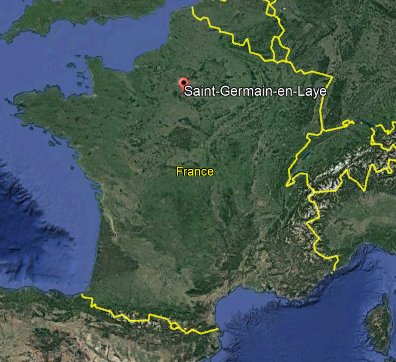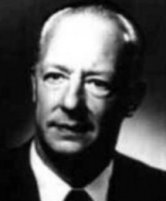
The index page for the 1954 French flap section of this website is here.
Reference for this case: 30-June-54-Saint-Germain-en-Laye.
Please cite this reference in any correspondence with me regarding this case.
Maurice Chatelain wrote in his 1975 book "Nos Ancêtres Venus du Cosmos" ("Our Cosmic Ancestors" in the US and U-K.) that for almost five years, from 1953 to 1957, Maurice Allais, director of the French National Centre of Scientific Research, performed experiments in terrestrial gravitation with a 12 kg pendulum, in his underground laboratory of Saint Germain on the west side of Paris.
The 1851 experiments of Leon Foucault showed that a pendulum always oscillates in the same plane with respect to outer space, in such a way that its plane of oscillation seems to rotate relatively to the surface of the Earth.
On 30 June, 1954, Maurice Allais watched his pendulum with particular attention as a total eclipse of the Sun was to happen that day around noon; which eventually could slightly modify the plane of oscillation of the pendulum. But Allais did not expect what happened.
When the eclipse started, the plane of oscillation of the pendulum suddenly shifted by 15 degrees, from 170° to 185°, stayed at 185° for the duration of the eclipse, and finally came back to its original position when the eclipse was over.
Chatelain explains that as far as we know, this had never happened before and it has never happened since.
The announcement of this fantastic phenomenon made a lot of waves in scientific circles at the time, and Allais was almost accused of having cheated.
Chatelain then gives his own explanation to this effect: the pendulum anomaly could very well be a signal by an extraterrestrial civilization to inform us of their existence.
[Ref. mcn1:] MAURICE CHATELAIN:
Maurice Chatelain wrote that for almost five years, from 1953 to 1957, Maurice Allais, director of the French National Centre of Scientific Research, performed experiments in terrestrial gravitation with a 12 kg pendulum, in his underground laboratory of Saint Germain on the west side of Paris.
The 1851 experiments of Leon Foucault showed that a pendulum always oscillates in the same plane with respect to outer space, in such a way that its plane of oscillation seems to rotate relatively to the surface of the Earth.
On 30 June, 1954, Maurice Allais watched his pendulum with particular attention as a total eclipse of the Sun was to happen that day around noon; which eventually could slightly modify the plane of oscillation of the pendulum. But Allais did not expect what happened.
When the eclipse started, the plane of oscillation of the pendulum suddenly shifted by 15 degrees, from 170° to 185°, stayed at 185° for the duration of the eclipse, and finally came back to its original position when the eclipse was over.
Chatelain explains hat as far as we know, this had never happened before and it has never happened since.
The announcement of this fantastic phenomenon made a lot of waves in scientific circles at the time, and Allais was almost accused of having cheated.
Chatelain then gives his own explanation to this effect: the pendulum anomaly could very well be a signal by an extraterrestrial civilization to inform us of their existence.

|
I must first state that whereas it may seem "odd" that I document this case in a catalog of UFO sightings, the reality is that already at this time, pioneering ufologists were trying to detect UFO flights by magnetic field variations detectors. The idea was indeed that a case of "flying saucer", "alien spacecraft", could consist of such a detection. In France in 1954, there had been such cases. There is therefore no reason why it should not be approached as such, even if the difference here is that it is not the experiencer who speaks of extraterrestrial craft, but an author who much later views the experience as having detected a "signal" sent by aliens.
(See the detector of the engineer and ufologist Jacques Baccard, and this alleged case of detection without visual observation on August 11, 1954 for example).
I do not document the affair on the grounds that I would think that it makes sense a priori in support of one or the other thesis; I document it because an allegation is made, in connection with France, the year 1954, ufology, and - alleged - extraterrestrials, in order to seek and give its explanation, whatever it is.
I must now clarify the circumstances of this case with the following additional information.

|
Maurice Chatelain is a character now largely forgotten in the history of ufology.
He was born in France in 1909, he became an engineer, and settled in the USA in 1955, where he took American nationality and worked for the Convair aircraft manufacturer, as electronic engineer in telecommunications, then telemetry then radar. He continued his career at Ryan Electronics, a spin-off of Ryan Aeronautical Company, and became, he says, head of the electromagnetism research group for radars and telecommunications.
At Ryan, he said, he was developing an automatic radar-controlled landing system; which would be used on the Ranger and Surveyor flights to the Moon.
He then worked for North American Aviation; which won the contract for the development and production of the Apollo spacecraft for NASA. He was responsible for developing and building audio and television transmission facilities between Earth and the Moon, including relay stations around the globe.
He he released his first book was in 1975 in France and 1978 in the USA, from which this case originates. I his book, he told that the Earth had been colonized by extraterrestrials or "Gods" a long time ago, of which we are partly the descendants. The book is a fat-fetched collection of themes such as "Ancient Astronauts", "Mayan Calendar", Atlantis, the Nazca lines, the cathedral of Chartres, the Anticythera machine, etc. He believed he has proven his thesis by discovering a "constant" of the solar system which he calls "Nineveh constant", calculated 65000 years ago and used in construction by our building ancestors educated by extraterrestrials. (A good part of the themes he used were taken from the seven books by Frenchman Robert Charroux from 1963 to 1974. Charroux largely forgotten now, was the real and very oddball "pioneer" of the genre. The most known "copier" of Charroux's rantings has was the Swiss Erich von Däniken, with 5 books from 1969 to 1975.) Chatelain sold his book fairly well in France, he was invited to Bernard Pivot's highly watched literary TV show Apostrophes on November 28, 1975, and also appeared promoting his book on September 6, 1980 in the science-fiction inspired TV program "Temps X" by the twins Igor and Grichka Bogdanoff.
Chatelain had often presented himself as the former chief of telecommunications of NASA during the Apollo missions, shameless lie since he had only worked for North American Aviation years before Apollo, never worked directly for NASA and never during the Apollo missions. The lie was nevertheless largely swallowed by certain "ufologists".
There is a story endlessly copied all over the web about the Apollo 11 astronauts reporting by radio to their Houston control center that they were seeing "spacecraft" and underground installations on the Moon they were orbiting. The story comes from his book, he claimed to have learned about it by indiscretion while working for NASA.

|
The unclassifiable Maurice Allais, born in Paris in 1911 and died in 2010, was a French economist and physicist, often presented as "Nobel Prize" winner (in reality "Prize of the Bank of Sweden in economic sciences in memory of Alfred Nobel"), in 1988.
He was appointed director of the French National Center for Scientific Research (CNRS) in 1946 and worked there until 1980.
Until 1960, he carried out parallel work in physics and economics, and tried to bring together sciences which he considered too separate: economics, sociology, psychology in particular.
What Chatelain says is almost accurate: what became known as the "Allais effect", or "Allais anomaly", has been alleged by Maurice Allais using lab equipment of the Institut de Recherche de la Sidérurgie (IRSID) in Saint-Germain-en-Laye near Paris. It is described as a possible physical phenomenon sometimes observed during solar eclipses, shown by disturbance in the movement of pendulums or gravitational measuring instruments. Allais thought he was in fact demonstrating that the speed of light considered to be constant whatever the movement of the observer, by Einstein [*], was not really constant (that the "ether" existed, that the speed of light depends on its direction relative to the observer); an idea totally rejected by all subsequent checks.
[*] It is often said that "the speed of light is constant". In fact, the speed of light varies, it is not the same in the vacuum or through glass or though water for example. In fact, what should be said is that the speed of light is "a universal physical constant and a relativistic invariant." If you look at a ray of light "passing" in front of you in a vacuum, it goes exactly at speed c. If you were able to "ride" the passing ray, you would expect to measure that the speed of light is now "at rest", zero speed with respect to you, but it is not so: if you measure this speed, it is still c, the same speed as when you watched the ray pass in front of you.
Allais thought that his anomaly detection was due to the fact that the Moon caused a "wind" which had changed the speed of light in the supposed ether, something impossible for Einstein, and Allais therefore thought that his anomaly proved that Einstein was wrong. Allais never thought, or at least never expressed, that his anomaly was caused by extraterrestrials.
It was a collaborator of Maurice Allais who reportedly noticed the anomaly during the eclipse of June 30, 1954, during measurements of the azimuth of the plan of oscillation of a paraconic pendulum.
There would have been a very strong indication of the existence of a phenomenon linked to the eclipse, with a very particular trajectory of abnormal deviation of the pendulum, with very clear concomitance with the eclipse. Maurice Allais said he never encountered it again throughout his observations (there would be another anomaly spotted by his instrument in 1958 linked to an eclipse, but weaker and with a very vague concomitance.
Maurice Allais published on this anomaly in "Anomalies des Mouvements du Pendule Paraconique", in Comptes Rendus de l'Académie des Sciences, #245, pp. 2001-2003, in 1957.
For a long time there was no consensus from the scientific community on the reality or the unreality of this alleged phenomenon. It will be said that no rigorous experimental protocol had been followed by Allais. An experiment repeated in China during the 1997 eclipse seemed to confirm the Allais effect, but its validity was also questioned because the protocol allowed for many biases. There were more rigorous experiments in Zambia and in Australia between 2001 and 2002, in which the anomalies were confirmed, but the experimenters estimate that they are explained by phenomena of movements of air masses. This is also the explanation of the Allais effect by Tom Van Flandern in the Physical Review for January 27, 2003:
"Gravitational and other anomalies seen repeatedly in connection with solar eclipses have led to speculation about a possible gravitational shielding effect as the cause. Here we show that an unusual phenomenon that occurs only during solar eclipses, rapid air mass movement for the bulk of the atmosphere above normal cloud levels, appears to be a sufficient explanation for both the magnitude and behavior of the anomaly previously reported in these pages."
(Full paper at https://journals.aps.org/prd/abstract/10.1103/PhysRevD.67.022002)
The "Allais" effect of June 30, 1954, is an alleged effect, but not strictly established; on other occasions later, with other experimenters, it appeared to be a real effect, measured more rigorously. But its most probable cause is not "an extraterrestrial signal", but movements of air masses in the upper atmosphere.
We must also wonder why Chatelain's supposed extraterrestrials would have sent this "signal" precisely at the time of an eclipse visible in Paris and stopped sending it when the eclipse was no more visible from Paris. Such a message could have been sent anytime and longer, if it was intended to be received; which is the purpose of a message. This lack of logic is typical of Chatelain's rantings: a fact A, questionable, in a circumstance B implies a cause C which has no relation to circumstance B other than, in this case, the association of idea Eclipse = Space = Extraterrestrials.
(These keywords are only to help queries and are not implying anything.)
Paris, Saint-Germain-en-Laye, Yvelines, Maurice Allais, Allais effect, effect, detection, message, SETI, eclipse
[----] indicates sources that are not yet available to me.
| Version: | Created/Changed by: | Date: | Change Description: |
|---|---|---|---|
| 1.0 | Patrick Gross | January 23, 2020 | First published, [mcn1]. |